Scarpa Mobe is essentially a fairly beefy resort skiing boot with a bit of walk mode capability. The boot is compatible with AT bindings (including tech) and yields a good deal more comfort than what many people experience with alpine boots. It is the stiffest boot I’ve ever toured in.
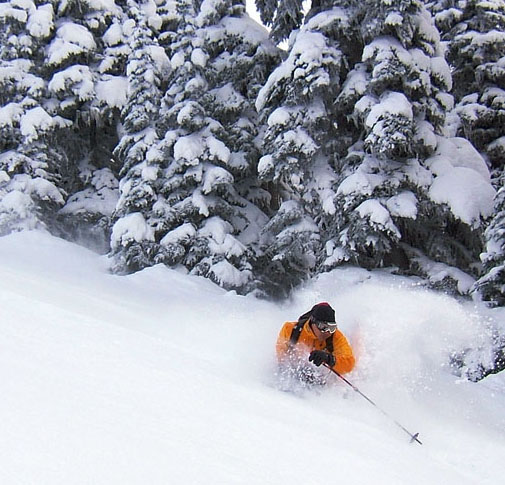
Early season pow on Blackcomb, skiing the Mobe
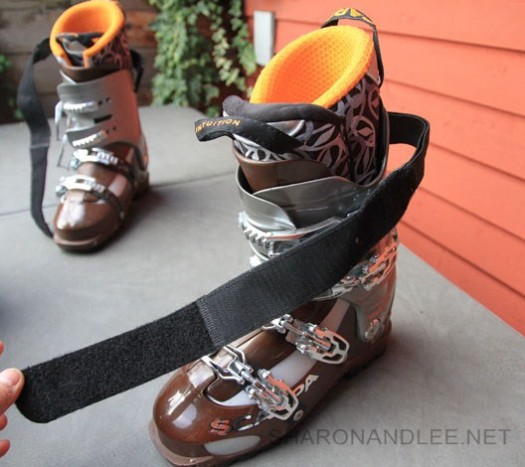
Scarpa Mobe boot -- standard tongue and four buckle construction. Cammed buckles are removable. Comes with the neoprene 'dynamic power strap'.
My Mobe review pair weighed a total of of 1800g per boot, size 27, BSL 305 (Scarpa claims 1790 grams). The included liner is a custom Intuition Luxury liner weighing in at 220g with a slightly thinner 5mm sole to accommodate people who want to use footbeds. Note that all weights are per boot, see other backcountry skiing boot weights here.
This is not a light boot. However, compare with other boots in this category and you can see that attention has been paid to weight-savings, so there is credence to this being a touring shoe (in my opinion, only the Dynafit Titan (2000g) and the BD Factor (2140g) come close in stiffness). Some Mobe weight-saving features below:
• “V-frame power ribs” are basically raised areas/ribs in the rear cuff. This drops some plastic off the rear cuff but the ribs add rigidity in an effort to keep Mobe stiff yet light.
• Magnesium buckles.
• No interchangeable alpine soles. This means Mobe is not suggested for use in alpine bindings (although the more adventurous among us might do so). This also means you do not get the micro-slop that boots with removable sole blocks sometimes produce.
• Intuition liner (lighter than all other liners yet usually comparably warmer and more performance-oriented).
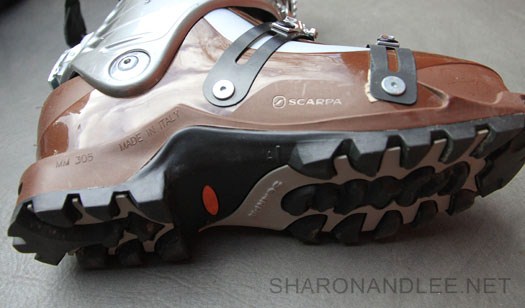
Skywalk sole on the Mobe (no interchangeable alpine and AT soles).
Fit and technical details
I have a wide forefoot and minimal arch but fit most boots without much customization. The Mobe has a new mold and a bit less forefoot volume than older Scarpa models but a forefoot last a touch wider at 104mm. I fit a 27.0 Mobe (305mm boot sole length) after molding the stock liner. Although the fit was comfortable, note that Mobe has a big heel pocket. Some people might need customization to get decent heel-hold.
The boot’s plastic is so stiff that buckling up can be a bit of an effort. I found Mobe to be especially sensitive to slight changes in buckle tightness so took some time to tune the fit. Fortunately this was easy as all four buckles have micro-adjustments. On the whole I had to resist the urge to overtighten either buckles or the ankle strap since the boot is so stiff that downhill performance was still very good even with the buckles being moderately tight. Overtighten, and your feet and shins will hurt without noticeable performance improvement.
More technical tidbits:
• Scarpa continues their laudable and WildSnow award winning tradition of user-serviceable & removeable buckles & mounting hardware. We beg you Scarpa, never quit doing this, and please, other boot makers, can’t you provide the same?
• Licensed Dynafit tech fittings with small arrows to indicate where you step-in (kind of useless in deep snow but useful in hardpack)
• In tour mode – the boot only reclines to + 5 degrees from vertical (more on how that affects touring later in this review).
• Ski mode lean is adjustable from 15 to 22 degrees.
• Removeable bootboard gives you customization options.
• Included is Scarpa’s “dynamic power strap”, wider, has neoprene but is lighter than a Booster strap (replaces the metal cam with velcro).
• Mobe is made out of Scarpa’s Pebax Rnew. I didn’t detect a substantial change in boot stiffness as temperatures fluctuated.
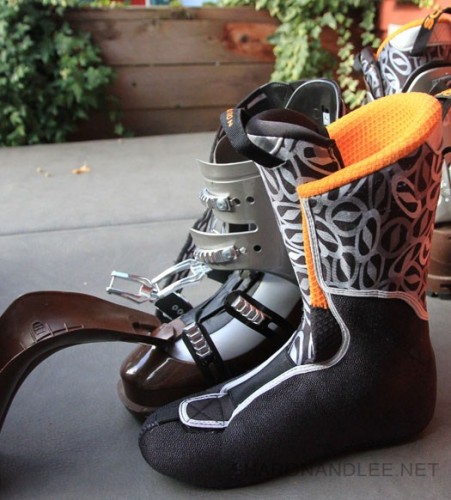
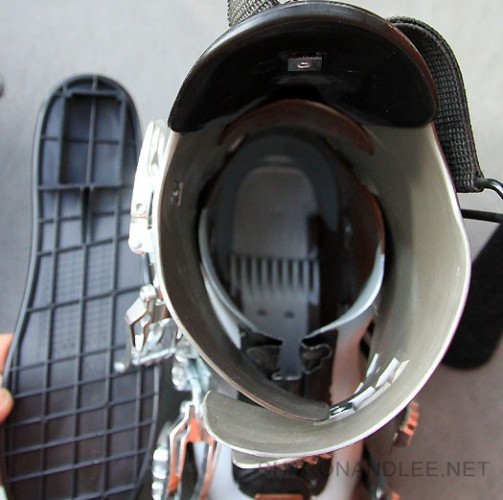
Mobe interior - note removable bootboards and hard stops to help limit forward travel.
On Snow Performance – Skiing
Mobe is rated as a 125 flex index boot. Despite much web chatter comparing different brands of boots using flex numbers, reality is that flex indices are only accurate as a comparison within a given company, and even then, who knows how they really test and rate. Thus, a number of 125 would indicate Mobe is the stiffest Scarpa boot (Hurricane is 120, Skookum and Typhoon are 110 while Maestrale is 100). I left Mobe in the 18 degree lean mode while skiing.
Since flex numbers are only a rough guide from company to company, old fashioned comparison is still the best way to figure out what’s what. So here you go: Mobe is stiffer than the Dynafit Titan and the BD Factor. To give even more context, I initially had the Mobe on a smaller light ski (177cms long Atomic TM:ex) and lost feel for the snow as the boot basically overpowered the ski. I had to ski a bigger ski (Kneissl Tanker in 180cms length) and ski quite aggressively to feel that Mobe was paired with the right set of sticks. I feel this is something inherent to the Mobe’s construction. For example, the Scarpa marketing literature waxes rhapsodic about the new Powerblock Tour ski/walk mechanism and how it is “a rigid interface…. a game-changer and in ski mode, this mechanism offers the closest thing on the market to the rigidity of a fixed cuff boot.” This is one of those situations when hype meets reality. Mobe is the closest boot I’ve yet seen which comes to the stiffness of a dedicated alpine boot yet at a relatively light weight.
Yet, is a boot this stiff what I really need, or you?
To answer the above eternal question, first, in my opinion Mobe is overkill for a skier of my weight & aggression level. I don’t charge terrain inbounds and would be considered to be on the conservative side when skiing inbounds. This is a big powerful gun and not for lollygagging. Thus, this is a boot for the bigger-boned crowd (boned in both senses of the word?) or for skiers who send it.
Second, although Mobe is stiff, it still does not have the smooth progressive feel of an alpine boot. That said, I have no wish to be unfair to Mobe, as no alpine touring boot I’ve skied matches the smooth power transmission of an alpine boot. I did find that Mobe skied better when I used a soft touring tongue. I attribute that perhaps to the softer tongue adding some progression and mitigating the slight harshness of power transmission endemic to all alpine touring boots. (Note the touring tongue is not included in-box but can be purchased from Scarpa retailers.)
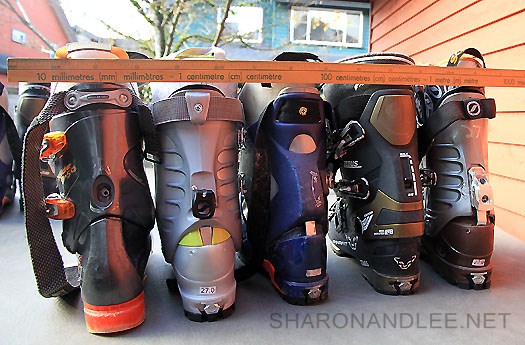
Comparison of rear cuff heights - from L to R: Atomic alpine boots, Scarpa Shake, Garmont Megaride, Dynafit ZZeus then Mobe. The ruler is held level. All the rear cuffs are within mm's of equal height except for the ZZeus (5mm) and Megaride (10mm) shorter.
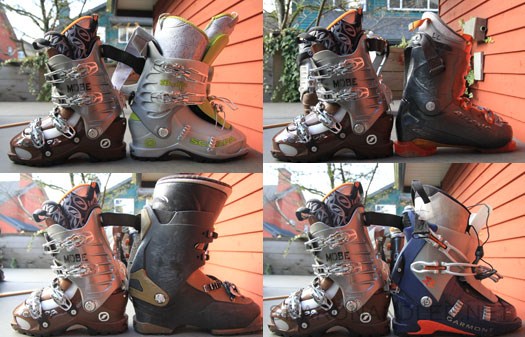
Side profiles of boots compared to Mobe from top left going clockwise - Shaka, Atomic alpine, ZZeus, Megaride. Mobe, ZZeus and the alpine boot are quite a bit taller than the Megaride and Shaka.
On Snow Performance – touring
No way to sugarcoat this. The Mobe’s touring performance is a compromise that falls far short of other Scarpa offerings The best you can get out of Mobe in walk mode is a forward lean of about 5 degrees. This limited cuff movement is a hindrance when skinning. Having said that, if you typically shuffle your feet when skinning or, more likely, if you’ve never used a boot with walk mode, the amount of rear cuff movement in Mobe will be more than adequate. However, if you’re used to taking long strides or if your tours involve flat approaches on glaciers or roads then you might consider a different boot. Mobe’s sub-optimal touring experience is somewhat alleviated by using a soft touring tongue but even then you’re not going to get a long stride out of these boots. I will add that I tried some other liners with the Mobe including a set of my own Intuition Protour liners. This did not help touring capability; it is mostly the shell (not the liner) which restricts boot movement.
I didn’t evaluate Mobe performance in rock/snow/ice scrambling, but can easily guess with how stiff this boot is, combined with its limited cuff travel, Mobe is not going to cause smiles in those situations. Nonetheless, Mobe is a comfortable shoe for short walks (it does have a rockered sole and the slight walk mode is very noticeable for walking comfort). As for sole wear, my test wasn’t long enough or rough enough to evaluate.
When reading my critique bear in mind that Scarpa markets Mobe to people who are mostly in the slackcountry or on short tours and presumably understand that touring performance is sacrificed with this boot. I’m told that one of the reasons Mobe is so stiff is that everything around the walk mode is beefed up so there’s no play there. But that also means a restricted walk mode for true backcountry skiing where you’re earning most or all of your turns.
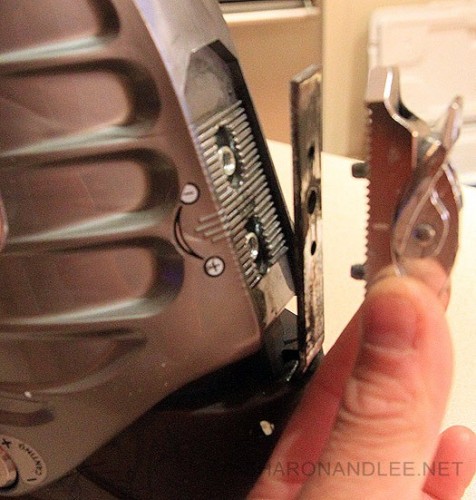
Mobe backcountry skiing boot lean lock adjustment.
Lean-lock adjustment for forward lean
Scarpa Mobe’s forward lean is adjustable between 15 to 22 degrees but there isn’t any documentation as to how to adjust the lean-lock mechanism. I had to figure this out myself along with the help of some other people in online postings. The mechanism is pictured above.
• You will need a 3mm allen/hexagonal key to loosen the walk mode mechanism on the walk mode bar.
• Adjust the forward lean with the boot in ski mode (not walk mode) so the hex head screws are lined up with the mechanism.
• Do not loosen the screws too much otherwise the mechanism will separate from the boot (as in the picture above) and it will be a pain to put it together again. Loosen it enough so the mechanism can slide up and down on the walk mode bar. Now put the mechanism in walk mode to move it up and down on bar.
• Align the mechanism with the markings on the outside of the boot on the heel. Put the mechanism back into ski mode before tightening (helps you align with the bar holes.
• Once aligned fully tighten the hex screws.
Summary
As a light, not overly aggressive skier who tours for powder the Mobe is too much boot for me. However, Mobe is most definitely a touring boot and even critics will have to note that it is relatively light and has many features tailored for touring including a rockered sole and a walk mode, albeit a walk mode with limited range. Scarpa has positioned the Mobe as a backcountry skiing boot for skiers who are more about the alpine than about the touring and it shows. Heavy aggressive skiers who crave downhill performance but want some modicum of tourability should look to the Mobe. But as I’m sure Scarpa would agree, if you want a more touring optimized boot with Scarpa’s sweet features, look at other offerings in the Scarpa line (such as Maestrale.)
Personal Biases
I weigh 160 lbs and ski mainly in the Coast Mountains of British Columbia in the Vancouver/Whistler area. My skiing is usually in fairly high moisture-content snow. Accordingly, my preference is for bigger skis and boots. I ski about a 100 days a season, 70% of which days involves some touring. I spent 8 days on the Mobe of which 6 were spent touring. I have used a variety of boots including the Garmont Megaride, Scarpa Spirit 3 and 4, Skookum, Maestrale, Dynafit ZZero4-C, Titan and ZZeus. If you have a question about the Mobes and want a comparison to other boots please ask questions using the comments section of this article.
(Lee Lau is an avid skier and outdoorsman embarking on many adventures with his loving, and sometimes concerned wife, Sharon. He has over fifteen years of experience backcountry skiing and dabbles in mountaineering. In the “off-season” he is occasionally found working in his day job as an intellectual property lawyer when he is not mountain biking. As a resident of Vancouver and Whistler, British Columbia, Lee’s playground extends mainly to Western Canada, including South West B.C. and the Selkirks. Lee and Sharon share experiences at www.sharonandlee.net)
Guest blogger Lee Lau is an avid skier and outdoorsman embarking on many adventures with his loving, and sometimes concerned wife, Sharon. He has over 15 years of experience skiing, ski-touring and dabbles in mountaineering. In the “off-season” he is occasionally found working in his day job as an intellectual property lawyer when he is not mountain biking. As a resident of Vancouver, British Columbia, Lee’s playground extends mainly to Western Canada, including South West B.C. and the Selkirks.
